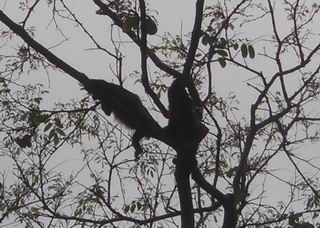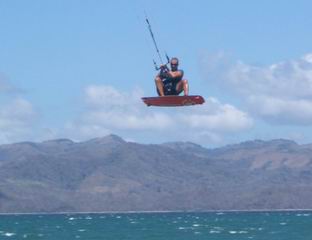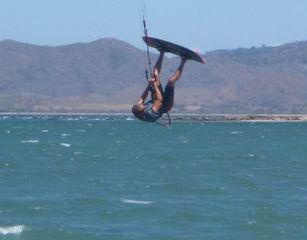|
|
|
|
Jan 22 – Feb 15, 2007 Sixaola – Cahuita – Puerto Limón – La Virgen – Fortuna – Arenal – Upala – La Cruz – Peñas Blancas |
|
|
Costa Rica is about half the size of Ireland and owes its topography to volcanic activity. With 115 volcanoes and 32 National Parks, beaches on both the Caribbean and Pacific shores and extensive tropical rain forest, it’s no wonder tourists have been flocking to this fertile and varied land for decades. What’s most remarkable for such a small country, is that the rainy season varies in duration from 3 to 12 months, depending on the location. Throughout the country, the temperatures are pretty consistent year round – on the coast somewhat warmer than in the highlands. |
|
|
We entered Costa Rica from Panama on the South East, crossing a rickety old bridge to immigration. The tough officer insisted on seeing our bicycles before stamping our passports. We thought this strange, but then discovered that tourists without a vehicle have to show a return/onward ticket for permission to enter the country. |
|
|
Banana plantations |
The first stretch was a continuation of the Chiquita banana plantation of Panama. If you have ever favoured the flavour of Chiquita over Dole or Del Monte bananas… you have been victim to excellent marketing campaigns. The only difference is that some grow to the left of the road and others to the right! So spread your custom and go for the ripest! |
|
Cahuita, conveniently situated between beaches and a national park, was our first stop. This laid-back village of cabinas (hotel rooms) and restaurants on unpaved streets has quite a Caribbean air about it. The locals, descendants from Jamaican immigrants from the mid-19th century speak a unique blend of English and Spanish and have a jovial outlook on life. It’s Bob Marley country over there and one of his look-a-likes decorates every street corner. |
|
|
Pura Vida, meaning something like "life at its best", is a standard greeting and reply to “how are you” ! Our first encounter with this expression was as we entered Cahuita. A well sloshed lad on horse back saluted us with an Imperial beer bottle shouting ¡Pura Vida! Welcome to Costa Rica! |
|
 Spot the sloths |
An 8-km walk along the beach leads through the Cahuita National Park. There, we spent the day sloth-spotting. These lumps of fur, high on the tree tops, hang out for hours on end, motionless, leaving the tree just once a week for their tree fertilization ceremony i.e. serious bowel movement! |
|
A creative jungle guide pointed out that the leaves they live on have a tranquilizing effect, thus retarding their evolution from a brown furry blob to an active, productive jungle beast! |
|
|
We also encountered, among the lizards, iguanas and raccoons, quite a few cheeky, white-faced monkeys. Equipped with a mind a lot faster then the sloths, they have figured out that bananas also grow in tourist day packs and are quite able and determined to harvest them against all odds. |
|
|
Lets turn off here... |
The road from Puerto Limón to the capital San José was very busy with container trucks going to and from their biggest Caribbean port. It was also on this stretch that we discovered that Tico (Costa Rican) truckers are very apt at avoiding potholes, but not so keen on giving much space to cyclists. So after 110km we were very happy to turn off on to country roads again. |
|
On the way to La Virgin, we cycled through beautiful green countryside, and the absence of traffic gave us time to admire volcanoes, forests, fields, flowers and an array of tropical birds. |
|
|
Passion flower |
Sarapiqui River area is home to 100s of Eco lodges offering tours of every conceivable description on the river and into the surrounding jungle. We stayed locally for a fraction of the price in a very spacious bungalow and had a toucan in the garden feasting on the papaya tree. |
|
We did take a guided jungle hike with a canopy walkway and spotted howler monkeys, fruit bats, frogs, lizards, tiger herons and a load of birds. |
|
|
Termites on the run... |
It was there that we learned that termites are edible and a good source of protein if you eat about 5,000 of them! We found that their nutty, woody taste can be somewhat improved on with a dash of soy sauce. |
|
On the way to Fortuna, we got drenched… but with a 12-month rainy season in this area, it is to be expected. We passed through kms of papaya, yucca (manioc) and pineapple plantations. Costa Rica is the world’s number one exporter of pineapples and according to the locals, they’re the best and the tastiest because of all the “vitamins and proteins they get from the volcanic soil!" |
|
|
Arenal volcano |
Arenal volcano is the 3rd most active volcano in the world and erupts every 10 to 15 minutes. It was in the evenings, when the clouds lifted that we were able to observe the red hot rocks being thrown from the crater with impressive rumbling noises. |
|
The second big attraction of the area is the proximity to thermal springs. We enjoyed an evening at Baldi Springs with 14 pools ranging in temperature from 12° to 67°C. Beautifully set in a tropical garden landscape, we soaked away the hours and came out new. |
|
|
Coatis |
Leaving Fortuna, we were accosted by dozens of Coatis living in perfect symbiosis with tourists. They provide the photo opportunity and the tourists supply the biscuits! |
|
We enjoyed the road to Arenal which followed an artificial lake with quite a few jungle stretches and great views, even if it was a constant up and down. |
|
|
|
|
|
Cloud forest |
There we turned off onto a gravel road leading to Ruta 4, all to avoid the Pan-American highway. This stretch brought us through almost Patagonian looking cloud forest, were it not for the occasional feral banana plant. |
|
It was here as we were descending one of the steeper
parts, that a delivery truck pulled up and Fausto jumped out to present
us with a big pineapple. We can assure you that it was indeed one of the
tastiest we’ve ever had and for sure loaded with local volcanic vitamins
and proteins. |
|
|
Cuddly road kill |
Road kill of late has included few new animals among them skunks, ant-eaters, hawks and frogs. If only we could transmit the endearing aroma that accompanies this cute cuddly black and white skunk! |
|
Kurt is getting very good at repairing punctures… and just as well as his present count stands at 19. Darina seems to have managed to avoid the thorns, glass and metal wire somewhat better, as after 20 months on the road she’s had only 12 flats. |
|
|
Leaf-cutter ant at work |
One of the more fascinating creatures in these parts is the leaf cutter ant. We observed a colony of them one afternoon cutting and carrying the raw material for their fungi production that they live of. It’s amazing how many sq. meters of plant material can be cut and delivered by these tiny animals in just a couple of hours. |
|
Outside Upala we met our first touring cyclist in Central America. Wolfgang (Switzerland) got himself enough time off work to cycle from Managua to Panama City. He reported headwind en route, which gave us great hopes of having tailwind in the not too distant future. |
|
|
Breakfast in Costa Rica |
Gallo pinto, a mix of black beans and white rice is the typical Tican breakfast. Generally it comes with a choice of eggs, chicken or beef and fried bananas, of course! For variety the Musanni bakery chain was a grand croissant/muffin stop before setting off for the day. |
| After passing Orosí Volcano, the landscape turned from lush green citrus plantations to crackling dry shrubbery. Temperatures rose dramatically and as we approached La Cruz above the Pacific coast the wind lifted and we could understand why kite-surfing is so popular in the area. |
|
|
|
The road down to Playa Copal offered a magnificent view over Salina's bay and after a steep descent and 10km on gravel we arrived at Liam and Claire’s hideaway. |
| Our regular readers will recall our first 4,000masl pass in Argentina with Liam and Claire from England. In Sucre, Bolivia, our trips led us in different directions. On reaching Isla Marguerita, Venezuela, Liam and Claire decided to give their bikes a well-earned retirement and headed for Costa Rica where they’ve been horse-riding, kite-surfing and identifying butterflies and moths these past few months. |
|
|
All remaining cyclists from Salta days have enjoyed Liam and Claire’s hospitality as they whizzed through Central America. We got in, in the nick of time, before they continued their extended honeymoon trip (now over a year!) up to Cancun, Mexico. |
|
|
|
Our days there were spent on the beach, intrigued by the circus attics of the kite-surfers. Harnessed up to a kite and with a board strapped to their feet the constant wind of this coast allows them to surf, jump and fly with dramatic crash landings when a gust blows in. |
| Liam was our hero, with his gravity defying moves on and above the water. |
|
 |
 |
|
The master himself... Liam |
|
|
We did manage to get Liam off the water one particular afternoon so that he and Claire could swear to our sanity. To read more about this special evening - click on surprise below. |
|
|
|
Our route in Costa Rica purposely avoided the capital San Jose, the busy Pan-American highway and the built-up Pacific coast. This resulted in a very enjoyable 3 weeks, on quiet roads with good food, friendly people and still enough attractions to keep us entertained. ¡Pura Vida! |
